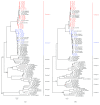Pretreatment Hepatitis C Virus NS5A/NS5B Resistance-Associated Substitutions in Genotype 1 Uruguayan Infected Patients
- PMID: 30186532
- PMCID: PMC6112080
- DOI: 10.1155/2018/2514901
Pretreatment Hepatitis C Virus NS5A/NS5B Resistance-Associated Substitutions in Genotype 1 Uruguayan Infected Patients
Abstract
Hepatitis C Virus (HCV) infection treatment has dramatically changed with the advent of direct-acting antiviral agents (DAAs). However, the efficacy of DAAs can be attenuated by the presence of resistance-associated substitutions (RASs) before and after treatment. Indeed, RASs detected in DAA treatment-naïve HCV-infected patients could be useful for clinical management and outcome prediction. Although the frequency of naturally occurring HCV NS5A and NS5B RASs has been addressed in many countries, there are only a few reports on their prevalence in the South American region. The aim of this study was to investigate the presence of RASs to NS5A and NS5B inhibitors in a DAA treatment naïve cohort of Uruguayan patients infected with chronic hepatitis C and compare them with reports from other South American countries. Here, we found that naturally occurring substitutions conferring resistance to NS5A and NS5B inhibitors were present in 8% and 19.2%, respectively, of treatment-naïve HCV genotype 1 infected patients. Importantly, the baseline substitutions in NS5A and NS5B herein identified differ from the studies previously reported in Brazil. Furthermore, Uruguayan strains subtype 1a clustered within all major world clades, showing that HCV variants currently circulating in this country are characterized by a remarkable genetic diversity.
Figures


Comment in
-
Comment on "Pretreatment Hepatitis C Virus NS5A/NS5B Resistance-Associated Substitutions in Genotype 1 Uruguayan Infected Patients".Dis Markers. 2018 Nov 5;2018:8698263. doi: 10.1155/2018/8698263. eCollection 2018. Dis Markers. 2018. PMID: 30524522 Free PMC article. No abstract available.
Similar articles
-
Prevalence of naturally occurring NS5A resistance-associated substitutions in patients infected with hepatitis C virus subtype 1a, 1b, and 3a, co-infected or not with HIV in Brazil.BMC Infect Dis. 2017 Nov 13;17(1):716. doi: 10.1186/s12879-017-2817-7. BMC Infect Dis. 2017. PMID: 29132303 Free PMC article.
-
Hepatitis C virus genotype 1 infection: Prevalence of NS5A and NS5B resistance-associated substitutions in naïve patients from Argentina.J Med Virol. 2019 Nov;91(11):1970-1978. doi: 10.1002/jmv.25536. Epub 2019 Jul 22. J Med Virol. 2019. PMID: 31273794
-
Patterns of Resistance-Associated Substitutions in Patients With Chronic HCV Infection Following Treatment With Direct-Acting Antivirals.Gastroenterology. 2018 Mar;154(4):976-988.e4. doi: 10.1053/j.gastro.2017.11.007. Epub 2017 Nov 13. Gastroenterology. 2018. PMID: 29146520
-
Hepatitis C virus drug resistance associated substitutions and their clinical relevance: Update 2018.Drug Resist Updat. 2018 Mar;37:17-39. doi: 10.1016/j.drup.2018.01.004. Epub 2018 Feb 21. Drug Resist Updat. 2018. PMID: 29525636 Review.
-
Future treatment of chronic hepatitis C with direct acting antivirals: is resistance important?Liver Int. 2012 Feb;32 Suppl 1:79-87. doi: 10.1111/j.1478-3231.2011.02716.x. Liver Int. 2012. PMID: 22212577 Review.
Cited by
-
First report on molecular docking analysis and drug resistance substitutions to approved HCV NS5A and NS5B inhibitors amongst Iranian patients.BMC Gastroenterol. 2021 Nov 24;21(1):443. doi: 10.1186/s12876-021-01988-y. BMC Gastroenterol. 2021. PMID: 34819046 Free PMC article.
-
Comment on "Pretreatment Hepatitis C Virus NS5A/NS5B Resistance-Associated Substitutions in Genotype 1 Uruguayan Infected Patients".Dis Markers. 2018 Nov 5;2018:8698263. doi: 10.1155/2018/8698263. eCollection 2018. Dis Markers. 2018. PMID: 30524522 Free PMC article. No abstract available.
-
Response to: Comment on "Pretreatment Hepatitis C Virus NS5A/NS5B Resistance-Associated Substitutions in Genotype 1 Uruguayan Infected Patients".Dis Markers. 2019 Feb 5;2019:2520302. doi: 10.1155/2019/2520302. eCollection 2019. Dis Markers. 2019. PMID: 30867847 Free PMC article. No abstract available.
-
The Relationship Between HCV-NS5A Gene Mutations and Resistance to Combination Therapy in Patients with HCV- Genotype 1-B.Rep Biochem Mol Biol. 2021 Jul;10(2):233-242. doi: 10.52547/rbmb.10.2.233. Rep Biochem Mol Biol. 2021. PMID: 34604413 Free PMC article.
-
Prevalence and Factors Related to Natural Resistance-Associated Substitutions to Direct-Acting Antivirals in Patients with Genotype 1 Hepatitis C Virus Infection.Viruses. 2018 Dec 21;11(1):3. doi: 10.3390/v11010003. Viruses. 2018. PMID: 30577623 Free PMC article.
References
MeSH terms
Substances
LinkOut - more resources
Full Text Sources
Other Literature Sources
Molecular Biology Databases

